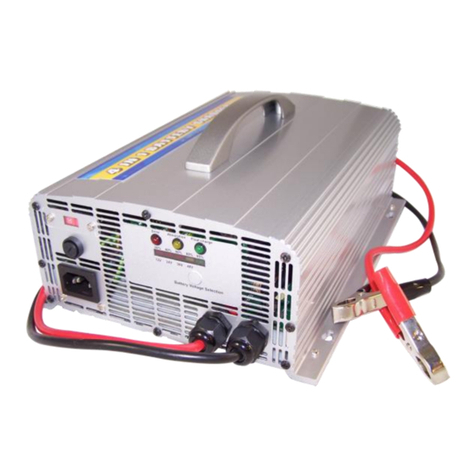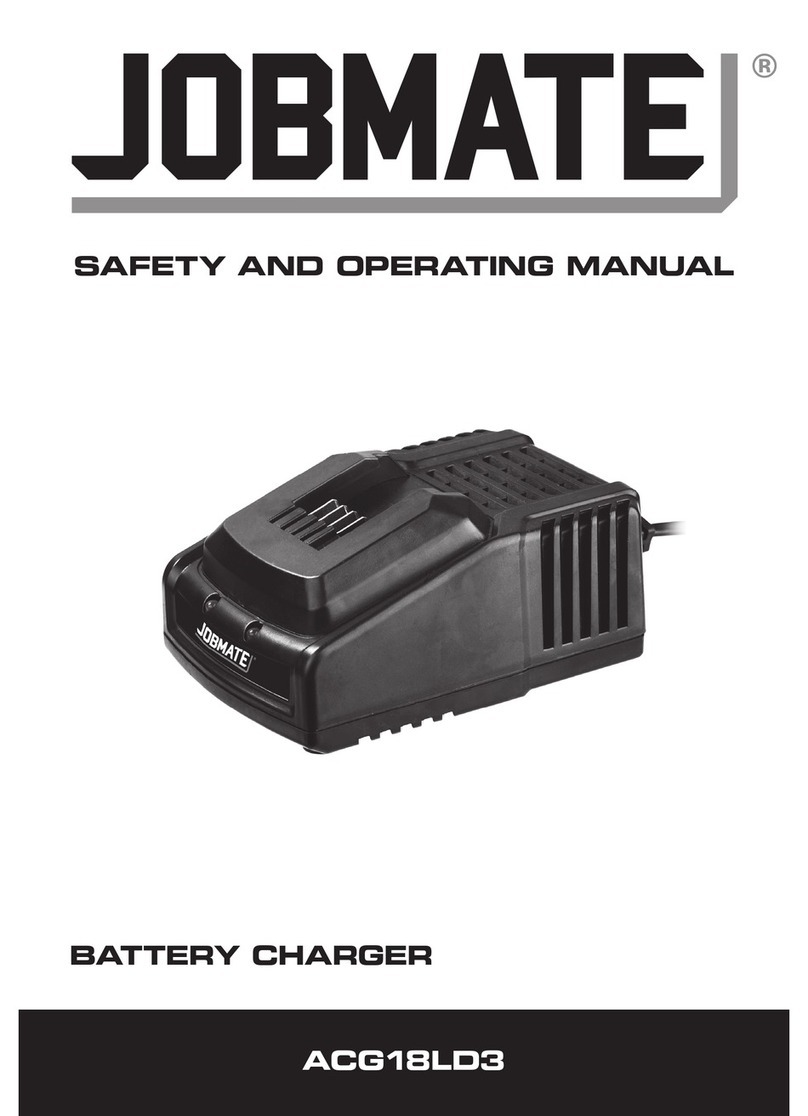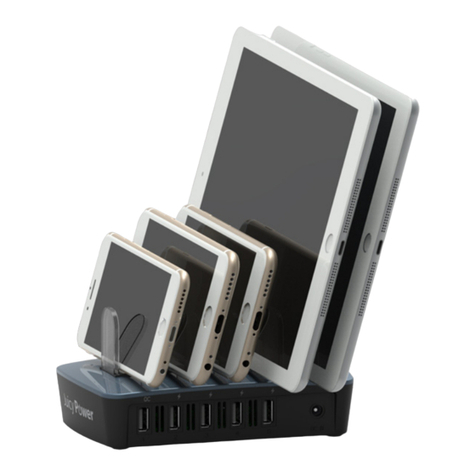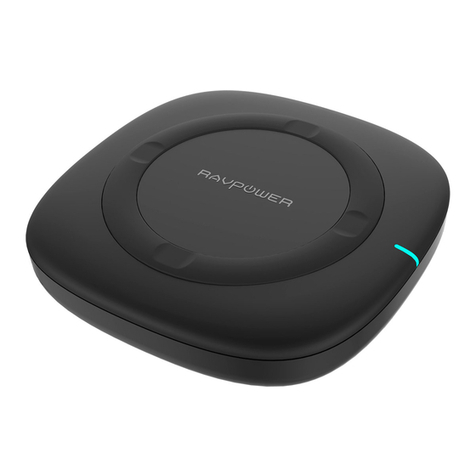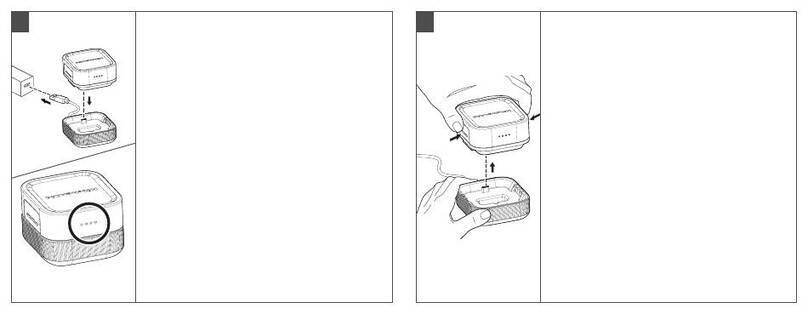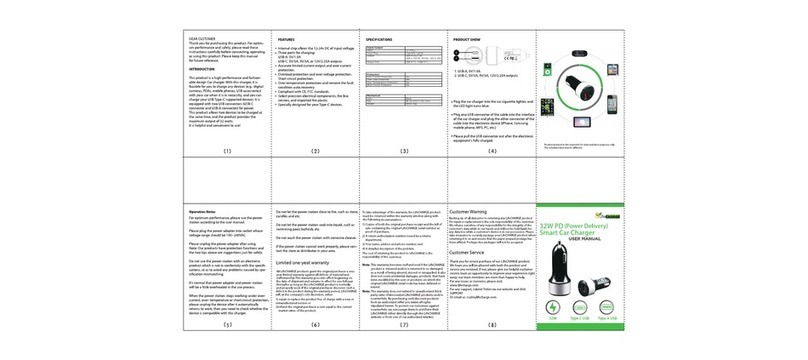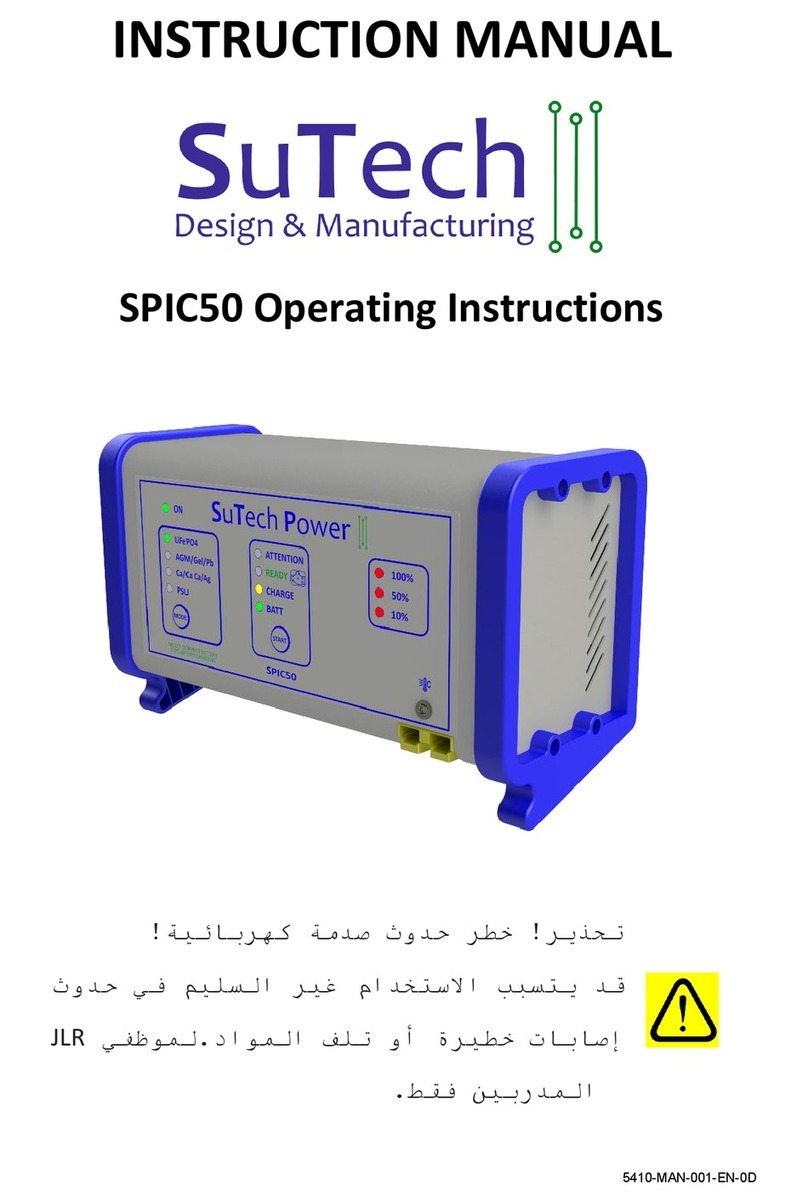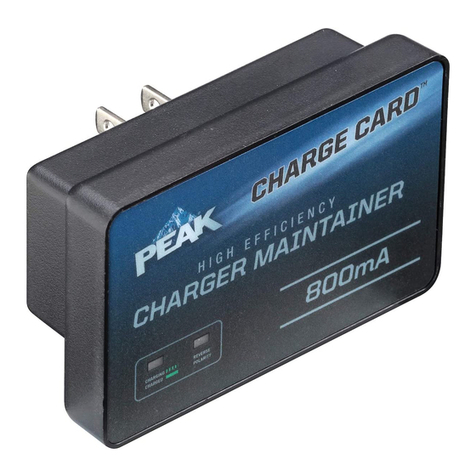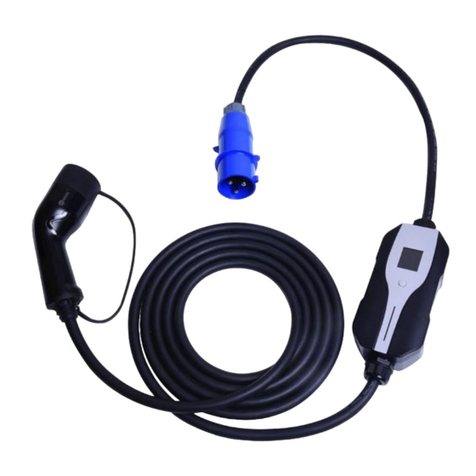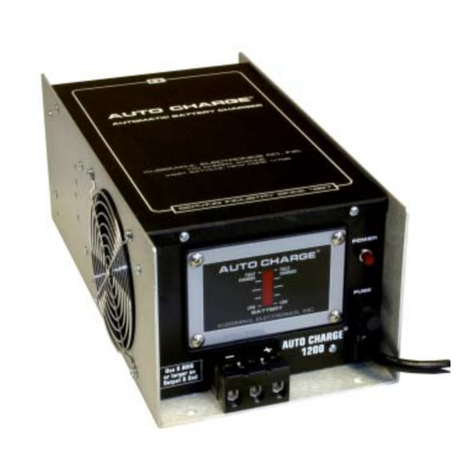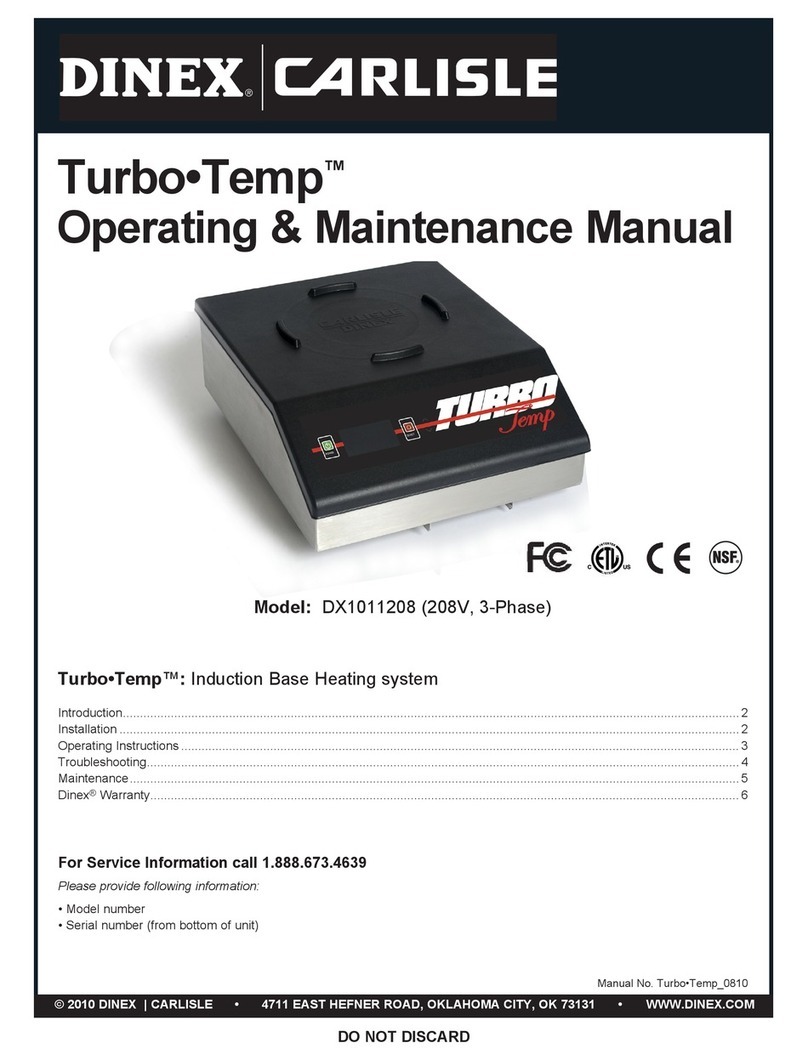Mr. Blacksmith 8997280 User manual

Charger
Owner’s Manual
WARNING: Read carefully and understand all ASSEMBLY AND OPERATION
INSTRUCTIONS before operating. Failure to follow the safety rules and other basic
safety
precautions may result in serious personal injury.
READ & SAVE THESE INSTRUCTIONS

Technical Specifications
Property
Specification
Input Rating
100-120V,50/60Hz,45W
Output
20VDC, 1.7A
Battery Type
Li-ion
Important Safety Information
Charger Safety Warnings
Read all safety warnings and all instructions.
Failure to follow the warnings and instructions may result in electric shock, fire and/or serious
injury.
Save all warnings and instructions for future reference.
The warnings, precautions, and instructions discussed in this instruction manual cannot cover
all possible conditions and situations that may occur. It must be understood by the operator
that common sense and caution are factors which cannot be built into this product, but must be
supplied by the operator.
1. The battery Charger gets hot during use. The Charger’s heat can build up
to unsafe levels and create a fire hazard if it does not receive adequate ventilation,
due to an electrical fault, or if it is used in a hot environment. Do not place the Charger on a
flammable surface. Do not obstruct any vents on the Charger.
Especially avoid placing the Charger on carpets and rugs; they are not only flammable,
but they also obstruct vents under the Charger.
Place the Charger on a stable, solid, nonflammable surface (such as a stable metal workbench
or concrete floor) at least 1 foot away from all flammable objects, such as drapes or walls.
Keep a fire extinguisher and a smoke detector in the area.
Frequently monitor the Charger and Battery Pack while charging.
2.Charge only designated battery packs; others may overheat, leak, or burst.
3.Follow charging instructions.
4. Do not insert damaged battery pack.
5. Check frequently while charging.

6. Wear ANSI-approved safety goggles during use.
7.Use chargers only with specifically designated battery packs. Use of any other battery
packs may create a risk of injury and fire.
8. When battery pack is not in use, keep it away from other metal objects, like paper clips,
coins, keys, nails, screws or other small metal objects, that can make a connection from one
terminal to another. Shorting the battery pack terminals together may cause burns or a fire.
9. Under abusive conditions, liquid may be ejected from the battery pack; avoid contact.
If contact accidentally occurs, flush with water. If liquid contacts eyes, additionally seek
medical help. Liquid ejected from the battery pack may cause irritation or burns.
10. Do not expose chargers to rain or wet conditions.Water entering a Charger will
increase the risk of electric shock. Charge indoors only.
11. Keep charging area clean and well lit. Cluttered or dark areas invite accidents.
12.Do not operate chargers in explosive atmospheres, such as in the presence of
flammable liquids, gases or dust. Chargers create sparks which may ignite the dust or
fumes.
13. Charger plugs must match the outlet. Never modify the plug in any way. Unmodified
plugs and matching outlets will reduce risk of electric shock.
14. Do not abuse the cord. Never use the cord for carrying, pulling or unplugging the
Charger. Keep cord away from heat, oil, sharp edges or moving parts. Damaged or
entangled cords increase the risk of electric shock.
15. Store idle chargers out of the reach of children and do not allow persons unfamiliar
with the Charger or these instructions to operate the Charger.
16. Maintain chargers. Check for breakage of parts and any other condition that may
affect the Charger’s operation. If damaged, have the Charger repaired before use.
17. Have your Charger serviced by a qualified repair person using only identical
replacement parts. This will ensure that the safety of the Charger is maintained.
18. Inspect before every use; do not use if parts are loose or damaged.
19. Use as intended only.
20. Unplug after use and before service, cleaning or storage.
21. Maintain labels and nameplates on the Charger. These carry important safety
information.If unreadable or missing, contact Harbor Freight Tools for a replacement.
22. This product is not a toy. Keep it out of reach of children.
23. People with pacemakers should consult their physician(s) before use.
Electromagnetic fields in close proximity to heart pacemaker could cause pacemaker
interference or pacemaker failure. In addition, people with pacemakers should properly

maintain and inspect to avoid electrical shock.
Lithium Battery Safety Warnings
1. DO NOT DO ANY OF THE FOLLOWING TO THE BATTERY PACK:
a.Open,
b.Drop,
c.Short-circuit,
d.Puncture,
e.Incinerate, or
f. Expose to temperatures greater than 140°F.
2. Keep Battery Pack dry.
3.Charge Battery Pack only according to its Charger’s instructions.
4.Inspect Battery Pack before every use; do not use or charge if damaged.
TO PREVENT ELECTRIC SHOCK AND DEATH FROM INCORRECT GROUNDING:
Check with a qualified electrician if you are in doubt as to whether the outlet
is properly grounded. Do not modify the power cord plug provided with the
charger. Do not use the charger if the power cord or plug is damaged. If
damaged, have it repaired by a service facility before use. If the plug will not
fit the outlet, have a proper outlet installed by a qualified electrician.
Extension Cords
Note: Extension cords must not be used with this Charger.
LITHIUM BATTERIES STORE A LARGE AMOUNT OF ENERGY AND WILL
VENT FIRE OR EXPLODE IF MISTREATED:
Grounding

Functions
Operating Instructions
Read the ENTIRE IMPORTANT SAFETY INFORMATION section at the
beginning of this manual including all text under subheadings therein
before set up or use of this product.
1.Place the Battery Pack on a dry fireproof surface in a room where the temperature is from
50–104°F.
Note: If recharging a newly spent Battery Pack, allow it to cool completely before
charging.
2.Examine the Battery Pack.
It must be undamaged, and an 20V, Lithium-ion type Battery Pack.
Do not charge a cracked, open, or leaking Battery Pack, or charge a non-recommended type
of Battery Pack.
3.The Battery Pack’s terminals are designed to fit this Charger specifically. If the Battery Pack
does to not fit the Charger properly, do not try to insert it. Do not force a Battery Pack into the
Charger.
4.Plug the Charger directly into a grounded, 120VAC, 60Hz receptacle.
5.Slide the Battery Pack onto the Charger.
6.While charging, the Battery Pack and Charger may become warm to the touch. This is
normal, and does not indicate a problem.
Note: If only the Red LED blinks, then the Battery Pack and/or Charger are not within the
correct charging temperature or there is a problem with the Battery Pack or Charger.
Allow the Battery Pack and Charger to reach the proper charging temperature.
Note: If the Green and Red LEDs both blink, then the Battery Pack or Charger may be
damaged. Have them inspected by a qualified technician before charging.

7.The Green LED will light continuously and the Red LED will blink when the Battery Pack is
charging. Both the Green and Red LEDs will light continually when the battery is charged.
Unplug the Charger and disconnect it from the Battery Pack when finished.
8.Allow the Battery Pack to cool completely before using it.
9.Press the Battery Button to release Battery Pack from the Charger.
Maintenance and Servicing
Procedures not specifically explained in this manual must be performed only by a
qualified technician.
TO PREVENT SERIOUS INJURY FROM ACCIDENTAL OPERATION:
Remove the Battery Pack and unplug the charger before performing any inspection,
maintenance, or cleaning procedures.
TO PREVENT SERIOUS INJURY FROM TOOL FAILURE:
Do not use damaged equipment.
If damage is noted, have the problem corrected before further use.
1.BEFORE EACH USE, inspect the general condition of the charger. Check for:
•loose hardware,
•misalignment or binding of moving parts,
•cracked or broken parts,
•damaged electrical wiring, and
•any other condition that may affect its safe operation.
2.AFTER USE, wipe external surfaces of the charger with clean cloth.
3.Disconnect Battery Pack and store Charger and any Battery Packs in a dry, indoor
area out of reach of children and away from metal objects (i.e., paperclips, coins) to
prevent shorting.
WARNING! TO PREVENT SERIOUS INJURY AND DEATH FROM ELECTRIC
SHOCK:
Do not open Base or Adapter. Do not service internal parts.

Distributed by
Forcome (shanghai) Co., Ltd
South Sizhuan Road,Shanghai 201612
Made in China

Chargeur
Mode d’emploi
3101943
AVERTISSEMENT : Lisez attentivement et comprenez toutes les INSTRUCTIONS
de l’assemblage et de fonctionnement avant d’utilisation. Le non-respect des règles de
sécuritéet d'autres précautions de base pouvait entraîner de graves blessures corporelles.
8997280
LISEZ ET CONSERVEZ CES INSTRUCTIONS

Spécifications techniques
Propriété
Spécification
Entrée nominale
100-120V,50/60Hz,45W
Sortie
20VDC, 1.7A
Type de Batterie
Lithium
Informations importantes sécuritaire
Avertissement de sécuritédu chargeur
AVERTISSEMENT
Lisez tous les avertissements et instructions de sécurité.
Le non-respect des avertissements et des instructions pouvait entraîner un choc électrique, un
incendie et/ou des blessures graves.
Conserver tous les avertissements et instructions pour référence future.
Les avertissements, les précautions et les instructions mentionnés dans la présente
instruction ne couvrent pas toutes les situations et circonstances qui peuvent survenir.
L'opérateur doit comprendre que le bon sens et la prudence sont des facteurs qui ne peuvent
être intégrés au produit, mais qui doivent être fournis par l'opérateur。
1. Le chargeur de batterie se réchauffe en service. S'il n'y a pas assez de
ventilation, la chaleur du chargeur peut s'accumuler àdes niveaux dangereux et présenter un
risque d'incendie en cas de défaillance électrique ou d'utilisation dans un environnement de
haute température. Ne pas placer le chargeur sur une surface inflammable. Ne bloquez pas
le trou d'aération du chargeur.
2. En particulier, veuillez éviter de placer le chargeur sur le tapis; ils sont non
seulement inflammables, mais ils bloquent également le trou d'aération du chargeur.
Placer le chargeur sur une surface stable, solide et non combustible (comme un établi
métallique stable ou un plancher en béton) placez-le au moins 1 pied de tout objet inflammable
comme le rideau et le mur. Placer les extincteurs et les détecteurs de fumée dans la zone.
1. Surveiller fréquemment le chargeur et la batterie pendant le chargement.
2. Charger uniquement pour la batterie désigné; d'autres batteries peuvent
surchauffer, fuir ou exploser.
3. Suivez les instructions de chargement
4. Ne pas insérer la batterie endommagée.

5. Surveiller toujours pendant le chargement
6. Porter des lunettes de sécurité approuvées par ANSI pendant l’utilisation.
7.Le chargeur ne peut être utiliséqu'avec des batteries désignées. L'utilisation de toute
autre batterie peut causer des blessures corporelles et un incendie.
8. Lorsque vous n'utilisez pas de batterie, éloignez-les d'autres objets métalliques tels que
l’agrafe, la monnaie métallique, le clé, le clou, la vis ou d'autre petit objet métallique qui
peuvent connecter une borne àun autre. Le court-circuit des bornes de la batterie peut causer
une brûlure ou un incendie.
9. Dans des conditions sévères, le liquide peut être éjectéde la batterie; évitez tout
contact. En cas de contact accidentel, rincer àl'eau. Si le liquide a contactéavec les
yeux, demandez immédiatement de l'aide médicale. Le liquide éjectéde la batterie peut
provoquer une irritation ou une brûlure.
10. Ne pas exposer le chargeur à la pluie ou à la condition humide. L’entrée de l'eau
dans le chargeur augmentera le risque de choc électrique. Charge uniquement à
l'intérieur.
11. Maintenir la zone de chargement propre et bien éclairée. Les zones encombrées ou
sombres peuvent causer des accidents.
12. Ne pas utiliser le chargeur dans des atmosphères explosives telles que des liquides
inflammables, des gaz ou de la poussière. Le chargeur produit des étincelles qui
peuvent enflammer la poussière ou la fumée.
13. La fiche du chargeur doit correspondre àla prise. Ne jamais modifier en aucune
façon la fiche. Les fiches non modifiées et les prises originales réduiront le risque de
choc électrique.
14. Ne pas abuser du fil d'alimentation. N'utilisez pas de fil d'alimentation pour
transporter, débrancher ou débrancher le chargeur. Éloigner la corde de la chaleur, de
l'huile, des bords tranchants ou des parties mobiles. Le fil endommagéaugmentera le
risque de choc électrique.
15. Gardez le chargeur inactif hors de la portée des enfants et ne pas laisser une
personne qui n'est pas familière avec le chargeur ou les instructions pour opérer le
chargeur.
16. Entretenez le chargeur. Inspectez les pièces pour éviter tout dommage et toute autre
condition susceptible d'affecter le fonctionnement du chargeur. Si le chargeur est
endommagé, réparez-le avant utilisation.
17. Utilisez les pièces de rechange pour réparer le chargeur par une personne qualifiée.
Cela assurera la sécuritédu maintien de chargeur.
18. Vérifier avant chaque utilisation et ne pas utiliser si les pièces sont desserrées ou
endommagées.

19. Utiliser uniquement comme prévu.
20. Débranchez-le après utilisation et avant réparation, nettoyage ou stockage.
21. Maintenir l'étiquette et la plaque sur le chargeur. ils ont des informations importantes
de la sécurité. S’il est impossible de lire ou manquant, veuillez contacter Harbor Freight
Tools pour le remplacement.
22. Ce produit n'est pas un jouet. Gardez-le hors de la portée des enfants.
23. Les personnes ayant un stimulateur cardiaque doivent consulter leur médecin avant
utilisation. Un champ électromagnétique près d'un stimulateur cardiaque peut causer
une interférence ou une défaillance du stimulateur cardiaque. De plus, la personne avec
un stimulateur cardiaque doit être correctement maintenue et inspectée afin d'éviter le
choc électrique.
Avertissement de sécuritéde la batterie au lithium
1. DO NOT DO ANY OF THE FOLLOWING TO THE BATTERY PACK:
NE PAS EFFECTUER L’UNE DES OPÉRATIONS SUIVANTES SUR LA BATTERIE:
a.Ouvert,
b.Tomber,
c.Court - circuit,
d.Percement,
e.Incinération, ou
f.Exposition àdes températures supérieures à140°F.
2. Maintenir la batterie sèche.
3.Charger la batterie uniquement selon les instructions du chargeur.
4.Vérifier la batterie avant chaque utilisation, ne pas utiliser ou charger en cas de dommages.
AVERTISSEMENT
POUR ÉVITER LE CHOC ÉLECTRIQUE ET LA MORT A CAUSE DE LA MISE À LA TERRE
INCORRECTE :
Si vous avez des questions sur la mise à la terre de la prise, contactez un électricien qualifié
pour vérifier. Ne pas modifier la prise du fil d'alimentation fourni avec le chargeur.
N'utilisez pas le chargeur si le fil d'alimentation ou la prise est endommagé.
En cas de dommages, veuillez le réparer au service avant utilisation. Si la fiche ne correspond
pas à la prise, installez la prise appropriée par un électricien qualifié.
LA BATTERIE AU LITHIUM PORTE DE GRANDES QUANTITÉS
D’ÉNERGIE, SI LA BATTERIE EST TRAITÉE INCORRECTEMENT, IL
PEUT CAUSER UN INCENDIE OU UNE EXPLOSION
Mise àla terre

Fil d’extension
Remarque: Le fil d’extension ne doit pas être utilisée sur ce chargeur
Fonctions
Instructions de l’opération
Lisez TOUTE LA SECTION DES INFORMATIONS IMPORTANTES SUR LA SÉCURITÉ au
début de ce manuel avant d'installer ou d'utiliser ce produit, y compris tout le texte
sous ses sous-titres.
1. Placer la batterie sur une surface sèche et ininflammable dans une chambre àune
température entre 50 et 104°F.
Remarque: Si vous rechargez la batterie nouvellement déchargée, laissez-la refroidir
complètement avant de la charger.
2. Examiner la batterie.
Il doit être intact et être une batterie lithium 20V.
Ne pas charger la batterie brisée, ouvertes ou qui fuie, ni le type de batterie non
recommandées.
3. Les bornes de la batterie sont spécialement conçues pour l'installation de ce chargeur.
Ne pas essayer d'insérer un chargeur si la batterie ne s'adapte pas correctement. Ne pas
forcer la batterie dans le chargeur.
4. Branchez le chargeur directement dans une prise de courant de terre de 120 VAC, 60 Hz.
5. Glissez la batterie sur le chargeur.
6. Pendant le chargement, la batterie peut devenir chaude au contact du chargeur. C'est normal,
il y a aucune problème.
Remarque : si seule la LED rouge clignote, la batterie et / ou le chargeur ne sont pas
dans la limite de température de charge correcte, ou il y a un problème avec la batterie ou
le chargeur. Laisser la batterie et le chargeur atteindre la température de charge correcte.
Remarque : si les LED vertes et rouges clignotent, la batterie ou le chargeur peut être
endommagé. Demandez àun technicien qualifiéde vérifier avant de charger.

7. sque le chargement, la LED verte reste allumée et la LED rouge clignote. Les LED vertes
et rouges restent allumées lorsque le chargement est fini. Débranchez le chargeur de la
batterie une fois terminé.
8. Laisser refroidir complètement la batterie avant utilisation.
9. Appuyez sur le bouton batterie pour libérer la batterie du chargeur
Entretien et Service
Les procédures qui ne sont pas spécifiquement expliquédans ce manuel ne
peuvent être exécutées que par des techniciens qualifiés.
AVERTISSEMENT
POUR ÉVITER LES BLESSURES GRAVES À CAUSE D’UNE MAUVAISE OPÉRATION:
Démonter la batterie et débrancher le chargeur avant d'effectuer toute procédure
d'inspection, d'entretien ou de nettoyage.
TO PREVENT SERIOUS INJURY FROM TOOL FAILURE:
POUR ÉVITER LES BLESSURES GRAVES À CAUSE D’UNE DÉFAILLANCE DE L’OUTIL
NE PAS utiliser d'équipement endommagé.
Si des dommages sont constatés, corriger le problème avant de continuer àutiliser.
1.AVANT CHAQUE UTILISATION, Vérifier l'état général de l'outil, veuillez vérifier :
·Matériel lâche,
·Non-alignement ou adhérence des pièces mobiles,
·Pièces endommagées ou cassées,
·Fils endommagés, et
·Autres conditions susceptibles d'affecter leur fonctionnement sécuritaire.
2. APRÈS UTILISATION, essuyer la surface extérieure de l'outil avec un chiffon
propre.
3.Déconnectez la batterie et entreposez la batterie, le chargeur et les outils dans un endroit
sèche, hors de la portée des enfants et loin des objets métalliques (par exemple, l’agrafe, la
monnaie métallique) afin d'éviter les courts-circuits.
AVERTISSEMENT! POUR ÉVITER LES BLESSURES ET LA MORT À CAUSE DE
CHOC ÉLECTRIQUE
N'ouvrez pas la base ou l'adaptateur. Ne pas réparer les pièces internes.

Distribuépar
Forcome (shanghai) Co., Ltd
Rue du sud du sizhuan, Shanghai 201612
Fabriquéen Chine
Table of contents
Languages:
